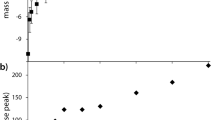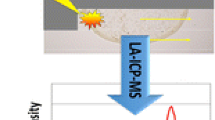Abstract
In the field of mass spectrometry imaging, typical experiments involve ionization directly from complex samples with no pre-ionization separation, relying on high resolving power mass analyzers to separate ions of interest. When an ion trapping step is involved in the analysis, the dynamic range of the analysis may be limited by the capacity of the ion trap, which is easily exceeded. To minimize collection of undesired ambient species while maximizing collection of analyte signal, accurate timing between ion generation and collection is a requirement. Here, a method for achieving synchronicity between infrared laser ablation and ion collection on a Q Exactive Plus mass spectrometer is described and demonstrated through measurement of ion accumulation at fixed time points following a laser ablation event with electrospray post-ionization of ablated material. In a model imaging experiment using infrared matrix-assisted laser desorption electrospray ionization, fixing the injection time at the minimum duration required to capture all ions generated by the last laser pulse in a sequence is shown to maximize target ion abundances. Using optimized timing is shown to yield a doubling or better of useful signal compared to previously used parameters.

Illustration of the effects of signal optimization on data quality for a single lipid species (cholesterol) measured from mouse liver tissue






Similar content being viewed by others
References
Takats Z, Wiseman JM, Gologan B, Cooks RG. Mass spectrometry sampling under ambient conditions with desorption electrospray ionization. Science. 2004;306:471–3.
Chang DY, Lee CC, Shiea J. Detecting large biomolecules from high-salt solutions by fused-droplet electrospray ionization mass spectrometry. Anal Chem. 2002;74:2465–9.
Mandal MK, Chen LC, Hashimoto Y, Yu Z, Hiraoka K. Detection of biomolecules from solutions with high concentration of salts using probe electrospray and nano-electrospray ionization mass spectrometry. Anal Methods-Uk. 2010;2:1905–12.
Shiea J, Huang MZ, HSu HJ, Lee CY, Yuan CH, Beech I, et al. Electrospray-assisted laser desorption/ionization mass spectrometry for direct ambient analysis of solids. Rapid Commun Mass Spectrom. 2005;19:3701–4.
Sampson JS, Hawkridge AM, Muddiman DC. Generation and detection of multiply-charged peptides and proteins by matrix-assisted laser desorption electrospray ionization (MALDESI) Fourier transform ion cyclotron resonance mass spectrometry. J Am Soc Mass Spectrom. 2006;17:1712–6.
Dixon RB, Muddiman DC. Study of the ionization mechanism in hybrid laser based desorption techniques. Analyst. 2010;135:880–2.
Robichaud G, Barry JA, Muddiman DC. IR-MALDESI mass spectrometry imaging of biological tissue sections using ice as a matrix. J Am Soc Mass Spectrom. 2014;25:319–28.
Barry JA, Robichaud G, Bokhart MT, Thompson C, Sykes C, Kashuba ADM, et al. Mapping antiretroviral drugs in tissue by IR-MALDESI MSI coupled to the Q exactive and comparison with LC-MS/MS SRM assay. J Am Soc Mass Spectrom. 2014;25:2038–47.
Makarov A, Denisov E, Kholomeev A, Baischun W, Lange O, Strupat K, et al. Performance evaluation of a hybrid linear ion trap/orbitrap mass spectrometer. Anal Chem. 2006;78:2113–20.
Olsen JV, de Godoy LMF, Li GQ, Macek B, Mortensen P, Pesch R, et al. Parts per million mass accuracy on an orbitrap mass spectrometer via lock mass injection into a C-trap. Mol Cell Proteomics. 2005;4:2010–21.
Bokhart MT, Rosen E, Thompson C, Sykes C, Kashuba ADM, Muddiman DC. Quantitative mass spectrometry imaging of emtricitabine in cervical tissue model using infrared matrix-assisted laser desorption electrospray ionization. Anal Bioanal Chem. 2015;407:2073–84.
Rosen EP, Bokhart MT, Nazari M, Muddiman DC. Influence of C-trap ion accumulation time on the detectability of analytes in IR-MALDESI MSI. Anal Chem. 2015;87:10483–90.
Nazari M, Muddiman DC. Polarity switching mass spectrometry imaging of healthy and cancerous hen ovarian tissue sections by infrared matrix-assisted laser desorption electrospray ionization (IR-MALDESI). Analyst. 2016;141:595–605.
Chambers MC, Maclean B, Burke R, Amodei D, Ruderman DL, Neumann S, et al. A cross-platform toolkit for mass spectrometry and proteomics. Nat Biotechnol. 2012;30:918–20.
Race AM, Styles IB, Bunch J. Inclusive sharing of mass spectrometry imaging data requires a converter for all. J Proteome. 2012;75:5111–2.
Robichaud G, Garrard KP, Barry JA, Muddiman DC. MSiReader: an open-source interface to view and analyze high resolving power MS imaging files on Matlab platform. J Am Soc Mass Spectrom. 2013;24:718–21.
Acknowledgements
The authors wish to thank Prof. Troy Ghashghaei from the NCSU Department of Molecular Biomedical Sciences and Prof. Heather Patisaul of the NCSU Department of Biological Sciences for providing the mouse liver and rat brain tissues, respectively. Financial support for this work was received from the National Institutes of Health (R01GM087964) and North Carolina State University.
Compliance with ethical standards
The authors declare no conflicts of interest.
Animal tissue samples used were obtained from an internal repository of tissue from animals managed in accordance with the Institute for Laboratory Animal Research Guide. All husbandry practices were approved by North Carolina State University Institutional Animal Care and Use Committee (IACUC).
Author information
Authors and Affiliations
Corresponding author
Additional information
Published in the topical collection celebrating ABCs 16th Anniversary.
Electronic supplementary materials
ESM 1
(PDF 728 kb)
Rights and permissions
About this article
Cite this article
Ekelöf, M., Muddiman, D.C. IR-MALDESI method optimization based on time-resolved measurement of ion yields. Anal Bioanal Chem 410, 963–970 (2018). https://doi.org/10.1007/s00216-017-0585-2
Received:
Accepted:
Published:
Issue Date:
DOI: https://doi.org/10.1007/s00216-017-0585-2




